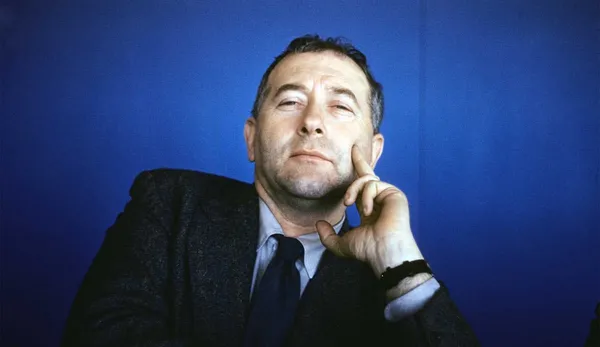Film clips from HC Potter’s Mr. Blandings Builds His Dream House and Frank Perry’s adaptation of John Cheever’s The Swimmer perfectly comment on how we are not dealing with characters played by Cary Grant and Myrna Loy or Burt Lancaster, but real people with real lives in James Crump’s enlightening Breuer’s Bohemia.
 |
| James Crump with Anne-Katrin Titze: “This incredible relationship that Gropius and Breuer maintained from the earliest days of the Bauhaus - they had their ups and downs, of course.” |
Crump (director of Antonio Lopez 1970: Sex Fashion & Disco on the famed fashion illustrator), dips briefly into the Bauhaus history where it all began and how Walter Gropius took Marcel Breuer with him to Harvard. In a letter from 1937 he tempts Breuer with “everything we like, those New England houses.” After Marcel and his wife Connie start a small architecture firm, held afloat by commissions by the families of students, the game changer comes in 1949, when his creation, House in the Museum Garden, takes over the sculpture garden of the Museum of Modern Art in New York.
The Gesamtkunstwerk with butterfly roof, Eames chairs, Eero Saarinen coffee pots, and doorknobs by Marcel Breuer himself catches the eye of brand new patrons. Two couples, Andrew Gagarin and his wife Jamie, and Rufus Stillman and his wife Leslie, their houses, entanglements, affairs, and illustrious friends are at the center of the film, and it is their children who inform us about this post-war world where so much seemed possible and so much was written in stone.
From Los Angeles, James Crump joined me on Zoom for an in-depth conversation on Breuer’s Bohemia and Marcel Breuer.
Anne-Katrin Titze: Hello James!
James Crump: Hi! Nice to see you!
AKT: What I really loved about your film is that it starts out with mid-century architecture and then it moves seamlessly into something quite different where we get so much about mid-century masculinity. It’s a beautifully sly movement where we don’t initially know where it is going. Can you talk about that flow?
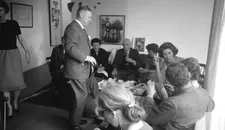 |
| James Crump: “I think the hedonism that comes out of the Bauhaus is really interesting and I think that plays a part in that notion of community.” Photo: Rufus Stillman, courtesy Breuer’s Bohemia |
JC: I think so. Well, I’m fascinated by Marcel Breuer, I’m fascinated by mid-century architecture. I studied Breuer for years, ever since I was a graduate student. I wasn’t interested in making a so-called academic film about architecture, or even a linear telling that would only appeal to specialists. I wanted to discuss that mid-century culture, that post-war culture.
Once I got into the stories and began to meet people who owned Marcel Breuer designed houses and in turn was introduced to children who actually grew up in these houses, it began to strike me that this was almost like a real life version of John Cheever’s The Swimmer, which later became a film.
AKT: I noticed you have a little clip there with Burt Lancaster’s backside.
JC: Absolutely. I use an epigram in the book [Breuer's Bohemia: The Architect, His Circle, and Midcentury Houses in New England, The Monacelli Press] which has to do with that particular scene. It was like a real-life version of Ang Lee’s The Ice Storm meets Frank Perry’s The Swimmer.
 |
| Marcel Breuer’s House in the Museum Garden at the Museum of Modern Art in New York Photo: courtesy Breuer’s Bohemia |
AKT: Right.
JC: These individuals I explore in the film in depth, like Rufus Stillman, who’s this incredible firebrand. To me he represents that period’s culture, at least in that particular socio-economic bracket of New York City. He’s this really interesting progressive person who gets married in the early Forties. He goes off to war as a First Lieutenant with one of General George S. Patton’s tank battalions and returns from the war with part of his left leg missing from a tank accident. And it didn’t affect him at all; he came back disillusioned but, and I think that represents the culture, he wanted something better for himself, his family, his community.
So I explored that through the architecture, wondering. He retains this amazing relationship with Marcel Breuer, who’s a serial commissioning patron and wondered if this relationship embodied or rejected the utopian promise of modernism. I was interested in the fallibility of these characters. They were really challenging New England traditions with these ideas about buildings, especially in Litchfield, Connecticut, where the locals had no interest. At the same time they were struggling with personal loss, alcoholism, all kinds of social problems
AKT: It is fascinating how you combine it with the architecture itself. There is a moment when you quote a letter of Gropius writing to Breuer about “the New England architecture that we love so much.”
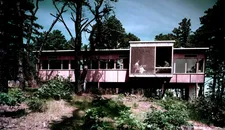 |
| James Crump: “At around 1940, he begins thinking about this Bohemian enclave in Wellfleet, Massachusetts on Cape Cod.” Photo: courtesy Breuer’s Bohemia |
JC: This incredible relationship that Gropius and Breuer maintained from the earliest days of the Bauhaus - they had their ups and downs, of course. At one point they split up around 1941. Breuer comes to the US to work at Harvard alongside Walter Gropius and then they have this split and he starts his firm which has a very challenging time to start during the war years. Around 1946, he leaves Cambridge and Harvard and goes to New York City to launch his eponymous firm. That’s when it gets interesting and his career starts to take off.
AKT: The timing is advantageous. The fact that they leave in 1937! How fortunate, how wonderful that Gropius gets Breuer to Harvard at that time!
JC: It’s not just Gropius and Breuer, but many of their colleagues, as many as they could get here, to try to preempt the upcoming war that was happening. It’s also interesting, you have Breuer coming here in 1938 to work with Gropius and shortly after at around 1940, he begins thinking about this Bohemian enclave in Wellfleet, Massachusetts on Cape Cod.
It’s an interesting connection to the Litchfield community, which was very influenced by this notion of community, bohemianism, gathering around yourself a contingent of people who have like minds. In the case of Stillman and Andrew Gagarin, they’re interested in left politics, the anti-war movement, local ecological affairs. They are very progressive and those two gentlemen came from privileged backgrounds, but they did a lot with the resources they had.
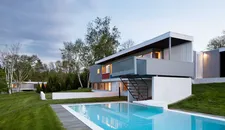 |
| Stillman House I with John Johansen’s Huvelle House Photo: courtesy Breuer’s Bohemia |
AKT: The region where Breuer came from in Austro-Hungary, that’s not considered Bohemia, is it? So your title only refers to the other meaning of the word?
JC: Exactly. I think the hedonism that comes out of the Bauhaus is really interesting and I think that plays a part in that notion of community. You have that interweaving of visual artists with playwrights.
AKT: Arthur Miller!
JC: Yes, writers like Phillip Roth, William Styron. It’s a really interesting mix.
AKT: Of course the close connection to [Alexander] Calder!
JC: The Calder connection is very interesting. He becomes friends with Breuer in the late Thirties and they collaborate on a lot of different projects in which Calder produces sculpture for architectural commissions. Calder also gives a beautiful mobile to Connie and Marcel Breuer in 1940 for their wedding. The Calder story weaves throughout the narrative.
AKT: Katherine Stillman comments on how much she liked Calder. I love that you have Katherine and Peter [Gagarin] talk about their parents. It’s a real inside look. I had never heard about the 1949 Breuer house in the sculpture garden of MoMA! It’s fascinating!
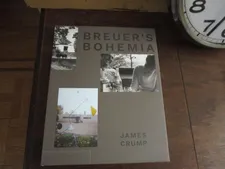 |
| Breuer's Bohemia: The Architect, His Circle, and Midcentury Houses in New England by James Crump Photo: Anne-Katrin Titze |
JC: It’s a very important commission that Breuer received from Phillip Johnson in 1948. It’s the first of three houses in the museum garden. This is the first one. In a way it’s a launching pad for the residential practice of Breuer’s in New York City. Through that commission thousands of people were introduced to modernist architecture.
At the time it was probably the most well-attended exhibition at the Museum of Modern Art. Indeed, the Stillmans were introduced to Breuer through that house. It was a very influential moment after the war; you have the GIs coming back, the government is supporting homeownership through mortgage programs.
AKT: I like very much how you followed that up with clips from Mr. Blandings Builds His Dreamhouse with Cary Grant, which is a film that I love.
JC: I love those clips. In fact, I recently visited Daniel Libeskind’s only residential design, which happens to be in Connecticut. And this house is right next to the field where that film was made.
AKT: Great, wow!
JC: It was actually filmed in Connecticut near the enclave of houses that I explore in the movie.
AKT: You enter into the past via a shot of the pool of a Stillman house and you switch from color to black and white before we move into the history.
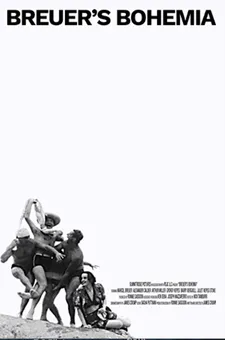 |
| Breuer's Bohemia poster |
JC: It’s actually the Stillman Cottage, which was completed in 1974. It’s a wonderful cottage on this high peak in Litchfield, overlooking this sort of alpine valley. It’s almost looking out into infinity.
AKT: Is that the one with the porch they call the tree house?
JC: Exactly. It’s based on that prototypical design.
AKT: Where Breuer was making goulash. Did you come across the recipe?
JC: I haven’t found it yet, but I think somebody might have it.
AKT: If you had that house, you wouldn’t want to eat anywhere else. I totally understand. The connection to playfulness and childhood comes across in the design. As much as they pretend to be adult men, there’s also a lot of childishness in it.
JC: That’s an interesting point.
Breuer's Bohemia is currently available on Vimeo on Demand. The Monacelli Press book Breuer's Bohemia: The Architect, His Circle, and Midcentury Houses in New England was released on September 14.
Breuer's Bohemia was scheduled to screen at the Architecture & Design Film Festival before it was canceled due to the Covid Delta variant surge.








